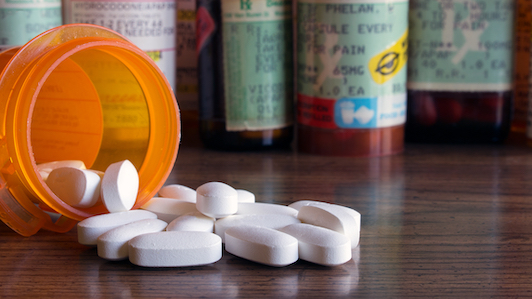Common examples of opioids include morphine, hydromorphone, and fentanyl, etc. When taken as instructed for pain, opioids are deemed safe. However, the potential risk of dependence and withdrawal, particularly with prolonged use of opioids, will always be present. Tolerance, which is a sign of physical dependence, occurs when the body requires more of the drug to create the same desired effect, for example, for pain relief. In this case, a patient experiencing opioid dependence will require higher doses for pain control which may then increase the risk of an overdose. High doses of opioids can lead to slowed breathing, low heart rate, low blood pressure, drowsiness, etc. On the other hand, when opioid use is suddenly stopped, the patient may experience withdrawal symptoms (which is also a sign of physical dependence), such as muscle pain, nausea, diarrhea, sweating and chills, and cravings for the drug. Patients experiencing withdrawal may continue to use opioids to avoid the undesirable symptoms. (Readers can learn more about Safe Use of Opioids at the https://myhealth.alberta.ca/ website where Patient Care Handouts are available with Care Instructions for opioid overdose, opioid withdrawal, reducing or stopping opioid medications, etc.) In general, it is important for patients to understand the risks and benefits of opioids, follow prescription instructions, and consult their pharmacists and healthcare providers accordingly regarding any concerns with opioid use.
Over-the-counter (OTC) medications in pain management
OTC medications are a great alternative to opioids for pain control. These medications are available without a prescription and do not present the same risks of dependence or withdrawal symptoms.
Non-steroidal anti-inflammatory drugs (NSAIDS)
Popular NSAIDs include ibuprofen, naproxen, and acetylsalicylic acid (ASA). A major caution of NSAID use is the risk of stomach bleeds. However, this can be prevented by taking the medication at the prescribed dose with food to prevent stomach upset. Stomach-acid reducing medications can also be incorporated with NSAID drug regimens to protect the stomach and avoid NSAID-associated gastrointestinal bleeds.
Acetaminophen
Another OTC medication commonly used for pain is acetaminophen. Besides being a pain reliever, Acetaminophen is also a common fever reducer that can be given, sometimes, with NSAIDs and opioids to provide additional fever or pain relief. Acetaminophen is usually well tolerated by patients, but at high doses, it could lead to liver damage. Therefore, it is essential to ensure that the dose/strength of Acetaminophen, whether in single-entity products or in combination OTC/prescription medications, is verified with your pharmacist or healthcare provider.
While NSAIDs, acetaminophen, and opioids are all pain relievers, opioids are the most potent and are often not required for the management of moderate pain. After exhausting OTC options, the rule of thumb is to take the lowest effective dose of an opioid medication for the shortest amount of time possible.
Opioid stewardship
According to the Public Health Agency of Canada (https://health-infobase.canada.ca/substance-related-harms/opioids-stimulants/), in 2022, our country grappled with a staggering toll of over 7000 opioid-related deaths. As healthcare providers with the ability to assess prescriptions, monitor drug effectiveness, and communicate with patients, pharmacists play a key role in preventing opioid overdoses and related patient safety events. Opioid stewardship refers to coordinated efforts and interventions to improve, monitor, and evaluate the use of opioids to support/protect public health and prevent harm. Pharmacists, healthcare providers, and patients/caregivers all have a role in opioid stewardship. Below are some selected strategies that everyone can be engaged in supporting safe opioid use.
Opioid education
When patients fill a prescription at a pharmacy, a medication information pamphlet detailing the benefits (or the use) and risks (or side effects) of the medication is usually provided. Similarly, when an opioid prescription is dispensed, in addition to the pamphlet, pharmacists can ensure that proper use of opioids, how to manage or prevent an overdose, and potential risks of opioids, etc., are addressed/discussed with the patient/caregiver during counseling and provide additional follow-up support/monitoring. When dispensing opioid medications to children, the Hospital for Sick Children Safe Opioid Checklist for Kids can be used for family/caregiver education. (https://assets.aboutkidshealth.ca/AKHAssets/OpioidSafetyChecklist.pdf)
Drug disposal programs
Any unused medications, opioids or not, should be brought back to the pharmacy and not be disposed of through regular household garbage.
Safe Labeling Procedures
Warning and auxiliary labels, particularly for opioids, should be applied on prescription vials/bottles to alert patient/caregivers to prevent medication safety incidents. Any medication or liquid vials/bottles containing controlled substances (e.g., opioids) should also have a child-safety cap.
Take-home naloxone kits
Naloxone is a life-saving medication that can be administered intranasally or intramuscularly during an opioid overdose incident. It is fast-acting and will temporarily reverse the effects of opioid overdoses. Pharmacists can educate patients on the use of Naloxone and provide them with a take-home Naloxone kit when an opioid medication is dispensed. Take-home naloxone kits are available at most pharmacies in Canada, and they do not require a prescription. Readers are encouraged to read more about Naloxone at https://www.canada.ca/en/health-canada/services/opioids/naloxone.html.)
The Institute for Safe Medication Practices Canada (ISMP Canada) developed an online resource on Opioid Stewardship (https://ismpcanada.ca/resource/opioid-stewardship/) to inform the public and healthcare providers about safe opioid use.
By Sheena Ye, Mona Mollaeizadeh, and Certina Ho


